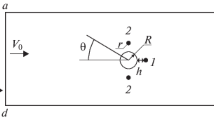Abstract
The construction and operation of a small-sized electrostatic engine are described. It consists of a rotor in the form of a thin-walled cylinder made from a dielectric material. There are two strips of metal foil along the two diametrically opposite generatrices of the cylinder. The gap between the longitudinal edges of the strips can be varied. Similarly, two electrodes, in the form of thin rigid plates with sharp edges facing the cylinder surface, are diametrically opposed to each other and parallel to the generatrices of the cylinder. Distances from the sharp edges to the surface of the cylinder have been varied. The device is powered by a highvoltage DC source providing a symmetrical bipolar corona discharge. Experimental dependences of the engine speed on the voltage between the electrodes for different geometrical parameters are given. Regression equations are derived and presented in a graphical form. An analytic substantiation of the engine operation principle is presented, and experimental and theoretical results are discussed.
Similar content being viewed by others
References
Jefimenko, O., Electrostatic Motors: Their History, Types and Principles of Operation, Washington: Integr. Res. Inst., 2011.
Verkhozin, A.I., Electrostatic engine as a thermodynamic system with two degrees of freedom, Vestn. Pskovsk. Gos. Univ., Ser. Est. Fiz. Mat. Nauk, 2013, no. 3, pp. 141–148.
Dyudkin, D.A., The new physical discovery: “The phenomenon of bodies rotation in the moving charges electric field”, Phys. Consc. Life, Cosm. Astrophys., 2007, no. 1, pp. 52–59.
Bushuev, V.A., Komarkovskii, L.I., and Lopatko, S.I., SU Patent 1294265, 1984.
Ostroumov, G.A., Vzaimodeistvie elektricheskikh i gidrodinamicheskikh polei (Interaction between Electric and Hydrodynamic Fields), Moscow: Nauka, 1979.
Melcher, J.R. and Taylor, G.I, Mechanics, Annu. Rev. Fluid Mech., 1969, vol. 111, no. 1, p. 68.
Zhakin, A.I., Electrodynamics of charged surfaces, Phys. Usp., 2013, vol. 56, no. 2, pp. 141–163.
Landau, L.D. and Lifshits, E.M., Gidrodinamika (Hydrodynamics), Moscow: Nauka, 1988.
Grosu, F.P. and Bologa, M.K. Electroconvective rotation of a dielectric liquid in external electric fields, Surf. Eng. Appl. Electrochem., 2010, vol. 46, no. 1, pp. 43–48.
Author information
Authors and Affiliations
Corresponding author
Additional information
Original Russian Text © M.K. Bologa, F.P. Grosu, V.D. Shkilev, I.V. Kozhevnikov, A.A. Polikarpov, 2015, published in Elektronnaya Obrabotka Materialov, 2015, No. 4, pp. 98–103.
About this article
Cite this article
Bologa, M.K., Grosu, F.P., Shkilev, V.D. et al. A corona-discharge dipole engine. Surf. Engin. Appl.Electrochem. 51, 401–405 (2015). https://doi.org/10.3103/S106837551504002X
Received:
Published:
Issue Date:
DOI: https://doi.org/10.3103/S106837551504002X




